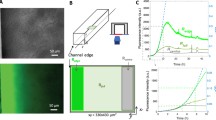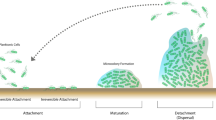Abstract
A plasmid vector containing two reporter genes,mer-lux andlac-GFP, was transformed to bothEscherichia coli andPseudomonas putida. Their cellular activities and biofilm characteristics were investigated in flow-cell units by measuring bioluminescent lights and fluorescent levels of GFP. Bioluminescence was effective to monitor temporal cell activities, whereas fluorescent level of GFP was useful to indicate the overall cell activities during biofilm development. The light production rates ofE. coli andP. putida cultures were dependent upon concentrations of HgCl2. Mercury molecules entrapped inP. putida biofilms were hardly washed out in comparison with those inE. coli biofilms, indicating thatP. putida biofilms may have higher affinity to mercury molecules thanE. coli biofilms. It was observed thatP. putida expressed GFP cDNA in biofilms but not in liquid cultures. This may indicate that the genetic mechanisms ofP. putida were favorably altered in biofilm conditions to make a foreign gene expression possible.
Similar content being viewed by others
References
Blenkinsopp, S. A. and J. W. Costerton (1991) Understanding bacterial biofilms.Trends. Biotech. 9: 138–143.
Melo, L. F., T. R. Bott, M. Fletcjer, and B. Capdeville (1992) Biofilms-science and technology. NATO ASI series E, vol. 223, Kluwer Academic Publishers, London.
Lyttle, H. A. and G. H. Bowden (1993) The level of mercury in human dental plaque and interaction in vitro between biofilms ofStreptococcus mutants and dental amalgam.J. Dent. Res. 72:1320–1324.
Brown, M. and J. N. Lester (1979) Metal removal in activated sludge: the role of bacterial extracellular polymers.Wat. Res. 13: 817–837.
Hintelmann, H., R. Ebinghaus, and R. D. Wilken (1993) Accumulation of mercury (II) and methylmercury by microbial biofilms.Wat. Res. 27: 237–242.
Silver, S. and T. K. Misra (1988) Plasmid-mediated heavy metal resistances.Ann. Rev. Microbiol. 42: 717–743.
Condee, C. W. and A. O. Summers (1992) Amerlux transcriptional fusion for real-time examination ofin vivo gene expression kinetics and promoter response to altered superhelicity.J. Bacteriol. 174: 8094–8101.
Virta, M., J. Lampinen, and Karp, M.. (1995) A luminescence-based mercury biosensor.Anal. Chem. 67: 667–669.
Freitas dos Santos, L. M. and A. G. Livingston (1995) Membrane-attached biofilms for VOC wastewater treatment 1: Novelin situ biofilm thickness measurement technique.Biotechnol. Bioeng. 47: 82–89.
Chalfie, M., Y. Tu, G. Euskirchen, W. W. Ward, and D. C. Prasher (1994) Green fluorescent protein as a marker for gene expression.Science. 203: 802–805.
Crameri, A., E. A. Whitehorn, E. Tate, and W. P. C. Stemmer (1996) Improved green fluorescent protein by molecular evolution using DNA shuffling.Nat. Biotechnol. 14: 315–319.
Ausubel, F. M., R. Brent, R. E. Kingston, D. D. Moore, J. G. Seidman, J. A. Smith, and K. Struhl (1994) Current protocols in molecular biology, John Wiley & Sons, Inc., New York.
Selifonova, O., R. Burlage, and T. Barkay (1993) Bioluminescence sensors for detection of bioavailable Hg(II) in the environment.Appl. Environ. Microbiol. 59: 3083–3090.
Stewart, P. S., A. K. Camper, S. D. Handran, C.-T. Huang, and M. Warnecke (1977) Spatial distribution and coexistence ofKlebsiella pneumoniae andPseudomonas aeruginosa in biofilms.Microb. Ecol. 33: 2–10.
Lawrence, J. R., P. J. Delaquis, D. R. Korber, and D. E. Caldwell (1987) Behaviour ofPseudomonas fluorescens within the hydrodynamic boundary layers of surface microenvironments.Microb. Ecol. 14: 1–14.
DeBeer, D., P. Stoodley, and Z. Lewandowski (1997) Measurements of local diffusion coefficients in biofilms by microinjection and confocal microscopy.Biotechnol. Bioeng. 53: 151–158.
Srinivasan, R., P. S. Stewart, T. Griebe, C. I. Chen, and X. Xu (1995) Biofilm parameters influencing biocide efficacy.Biotechnol. Bioeng. 46: 553–560.
Author information
Authors and Affiliations
Corresponding author
Rights and permissions
About this article
Cite this article
Khang, YH., Burlage, R.S. In situ monitoring of biofilm formations ofEscherichia coli andPseudomonas putida by use of lux and GFP reporters. Biotechnol. Bioprocess Eng. 3, 6–10 (1998). https://doi.org/10.1007/BF02932475
Issue Date:
DOI: https://doi.org/10.1007/BF02932475




